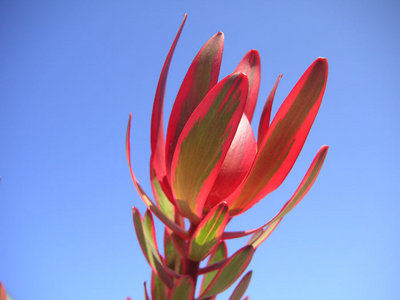Whether it comes from vivid foliage, bright berries, interesting bark or flowers, it pays to add to your color palette every month of the year. That’s why it’s so valuable to see what’s available in February, as well as in summer, spring and fall.
I’m a pushover when it comes to striking foliage plants. I find them every bit as vibrant as flowers. Bright flowers might be the frosting on the landscape, but brilliant foliage is the cake. Here are some of my favorites that will add color to your garden this month.
Leucadendron “Jester,” a sport of Safari Shine, is a drought-tolerant shrub that’s especially showy this time of year, when the flowering bracts turn deep red. Growth is slow and compact to maybe 3 to 4 feet. It looks like a striped carnival has hit town with its broadly edged creamy white-to-buff yellow leaves that take on coral pink tints in cold weather, especially toward the tips. It’s hardy to 20 degrees.
Correa “Wyn’s Wonder” is another favorite in the winter. Bright reddish-pink fuchsia-like flowers dangle from this 2- to 3-foot-tall variegated evergreen shrub. Hummingbirds love these flowers from fall through winter. Easy to grow in full sun or part shade, it’s hardy to 20 to 25 degrees.
What’s not to love about a plant with both intensive fragrance and variegated foliage? I’m talking about Daphne odora “Aureomarginata,” which is in bloom right now. A colorful sport discovered in England, called “Rebecca,” has the same sweetly scented pink flowers, but the leaves are more vividly variegated than the original. The stripes are wider and more buttery yellow, and the flowers are a softer shell pink. These gorgeous little shrubs get a bad name for being finicky to grow. Less is more when it comes to their care. They thrive in partial shade in humus-rich soil with good drainage. Don’t keep them soggy during the summer, or they succumb to crown and root rot. They don’t transplant well but are quite deer-resistant. Daphnes are not long lived, usually lasting 8 to 10 years.
I also am partial to Nandina, especially in winter, when the foliage turns as bright red as the berries. “Sienna Sunrise” is useful when you need a narrow 3- to 4-foot-tall plant, maybe near the front door, while the variety “Gulf Stream” fills a 3-foot-by-3-foot space with the same vibrant red foliage in the cool months.
What to do in the garden in early February
– Cut back woody shrubs. To stimulate lush new growth on plants like Mexican bush sage, artemisia and butterfly bush cut them back to within a few inches of the ground. Don’t use this approach on lavender or ceanothus, though; only lightly prune them after blooming. Prune back fuchsias by a third and remove dead, crossing branches and interior twiggy growth. Container fuchsias can be cut back to the pot rim.
– Cut back hydrangeas if you haven’t already done so, and apply a soil acidifier if you want the flowers blue. Although sulfur is the traditional favorite to quickly acidify the soil, it is not as kind to many beneficial soil microorganisms. Coffee grounds, pine needles, peat moss and cottonseed meal are kinder to the soil.
– Don’t cut back grasses yet, if you get frost in the area where they grow.
– Don’t prune spring-flowering shrubs and trees — such as lilacs, flowering cherries, plums and crabapples, rhododendrons, azaleas, camellias, weigela and spirea — until after they flower.
– Wait to prune back perennials that might have their new foliage damaged in a late frost.
– Prune frost-damaged shrubs if you can tell how far down the die-back goes; otherwise, wait until growth starts in the spring.
Jan Nelson, a landscape designer and California certified nursery professional at Plant Works in Ben Lomond, will answer questions about gardening in the Santa Cruz Mountains. Contact her at ja******@*ol.com or JanNelsonLandscapeDesign.com.











